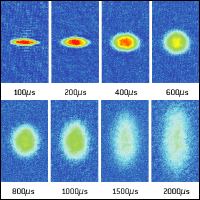 Image: JOHN E. THOMAS Duke
University SUPERFLUID? An ultracold gas of
lithium 6, initially compressed in a thin cylinder, expands radially
when released--a result that is suggestive of superfluidity but is
not conclusive. The sequence runs from 0.1 to 2.0 milliseconds after
the release. |
This superfluid state involves a broad class of quantum particles called fermions. According to quantum mechanics, all particles in nature are either bosons or fermions. The distinct characters of these two classes become most accentuated at very low temperatures: Bosons sociably gather all in a single quantum state, forming a Bose-Einstein condensate. Fermions, in contrast, act as individualists, no two occupying the same quantum state. As things cool, fermions increasingly occupy the lowest energy states, but they stack up one to a state, like people crowded onto a narrow flight of stairs. This state, in which most of the lowest energy states are occupied by one fermion each, is called a degenerate fermi gas.
In 1999 Deborah S. Jin and Brian DeMarco of JILA in Boulder, Colo., produced the first degenerate fermi gas of atoms in a tiny cloud of potassium atoms in a magnetic trap. But such a degenerate gas is only half the story. In similar degenerate systems that occur in liquid helium 3 and among electrons in superconductors, something new happens--some of the fermions form up in pairs called Cooper pairs. These pairs, which are bosonic, then form a superfluid state very similar to a Bose-Einstein condensate: in helium 3 it is responsible for the liquid's superfluid properties; in a superconductor it allows the resistanceless flow of electricity.Can such a superfluid state be made in the gaseous fermion systems? Theory predicts that atomic Cooper pairs usually will form only at a temperature much colder than that required for degeneracy, a temperature that seems beyond the reach of experiment at the moment. Recently, however, an alternative method was suggested, based on the fact that Cooper pairing depends on not just the temperature but also the interaction between the atoms. So instead of making the gas colder, why not increase the interaction? Nature has fortuitously provided a convenient way to adjust the interaction--by applying a magnetic field of just the right strength to create what is called a Feshbach resonance, which generates a powerful attractive or repulsive interaction between the atoms. (An attractive one is needed for Cooper pairs to form.)
In late 2002 a group led by John E. Thomas of Duke University used these techniques with lithium 6 atoms to produce results highly suggestive of superfluidity. The trapped gas formed a thin cylinder, and when the trapping laser beams were turned off, the gas expanded radially to form a disk shape--very little expansion took place along the axis of the cylinder. Such anisotropic expansion had previously been predicted to be a hallmark of the superfluid state.As the Duke group pointed out, however, other effects can also generate such anisotropic expansion. Indeed, experiments conducted earlier this year by Jin's group and by Christophe Salomon and his co-workers at the École Normale Supérieure in Paris have exhibited similar anisotropic expansions in situations where a superfluid cannot be present.
A technique for directly detecting the Cooper pairs or the superfluid is needed. Jin, as well as Wolfgang Ketterle's group at the Massachusetts Institute of Technology, recently reported using radio waves to study the precise states of the atoms in the trapped degenerate gas; if Cooper pairs were present, the binding energy of the pairs should show up clearly. Neither group saw such signs of Cooper pairs, but both uncovered useful new details of how fermionic atoms interact near a Feshbach resonance.
Several teams have recently studied the formation of loosely bound two-atom
molecules in their gases. "We hope that we can turn [the molecules]
into Cooper pairs," Ketterle says. And in August theorist Yvan Castin
and his co-workers at the École Normale Supérieure suggested just how
that might be done: first let the molecules Bose-condense, then adjust
the Feshbach resonance. If that is true, experimenters are just two
steps from their goal.